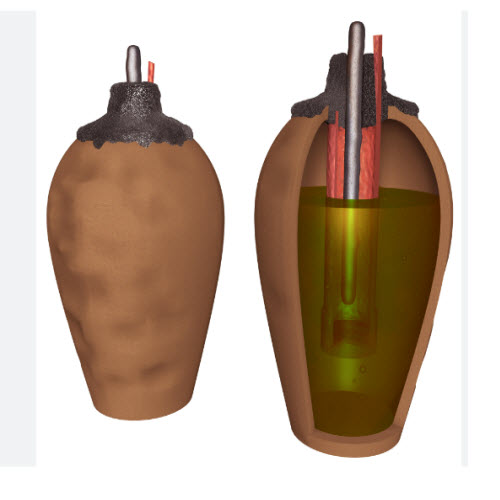The Baghdad Battery, also known as the Parthian Battery, is an archaeological artefact that has sparked significant interest and controversy. Discovered in the vicinity of Baghdad, Iraq, in the 1930s, the Baghdad Battery has been a subject of debate among historians, archaeologists, and scientists due to its enigmatic nature and potential implications. This article delves into the origins, construction, possible uses, and theories surrounding the Baghdad Battery, shedding light on one of the ancient world’s intriguing mysteries.
Discovery and Appearance: The Baghdad Battery was uncovered by German archaeologist Wilhelm Konig in 1936 during an excavation near the village of Khujut Rabu, southeast of Baghdad. The artefact consists of a clay pot approximately 5-6 inches in height, sealed at the top with an asphalt plug. Inside the pot, there is a copper cylinder, slightly narrower than the pot, which serves as a central rod. Encircling the central rod is an iron rod that acts as a cathode. Separating the two rods is a thin sheet of insulating material, possibly bitumen or asphalt. This construction closely resembles that of a rudimentary battery or electric cell.
Ancient Mesopotamian Context: The Baghdad Battery is believed to date back to the Parthian or Sassanian periods of ancient Mesopotamia, roughly between 250 BCE and 224 CE. During this time, the region was known for its advancements in science, mathematics, and engineering. Mesopotamia was home to several civilizations, including the Sumerians, Akkadians, Babylonians, and Persians, who made remarkable contributions to human knowledge and technological development.
Possible Uses and Functionality: The exact purpose of the Baghdad Battery remains uncertain, as no definitive evidence exists to confirm its intended use. However, several theories have emerged regarding its potential functions:
Electroplating: Some researchers propose that the Baghdad Battery could have been used for electroplating various objects with a thin layer of metal, such as gold or silver. This hypothesis is supported by the discovery of ancient artefacts with thin, well-preserved metal coatings that could be linked to the use of an electroplating process.
Medical Applications: Another theory suggests that the battery might have been employed in ancient medical practices, such as pain relief or electrotherapy. Ancient texts mention the use of electric fish for medicinal purposes, which implies an understanding of the potential therapeutic effects of electricity.
Ceremonial or Religious Use: Considering the ancient Mesopotamians’ strong religious beliefs, some speculate that the Baghdad Battery might have been used in religious ceremonies or rituals. It could have been part of lighting or other electrical displays that symbolized divine power.
Controversy and Skepticism: Despite these theories, the Baghdad Battery’s purpose remains disputed, and some scholars express scepticism regarding its function as a battery or electric cell. Critics argue that the artefacts may have served unrelated purposes, such as containers for scrolls or religious relics. Additionally, they question whether the ancient Mesopotamians possessed the necessary knowledge and understanding of electricity to utilize such a device effectively.
Alternative Explanations: In contrast to the battery hypothesis, alternative explanations have been put forward to challenge the prevailing theories. Some researchers propose that the Baghdad Battery was used for electroplating objects with a non-electrochemical process, utilizing vinegar or acidic liquids to accelerate metal deposition. Others suggest that the artefact might have been associated with early galvanic cells used for gilding or metalworking.
Conclusion: The Baghdad Battery remains a fascinating artefact from ancient Mesopotamia that continues to intrigue historians and scientists alike. While its purpose and functionality remain uncertain, the Baghdad Battery provides a glimpse


Leave a Reply